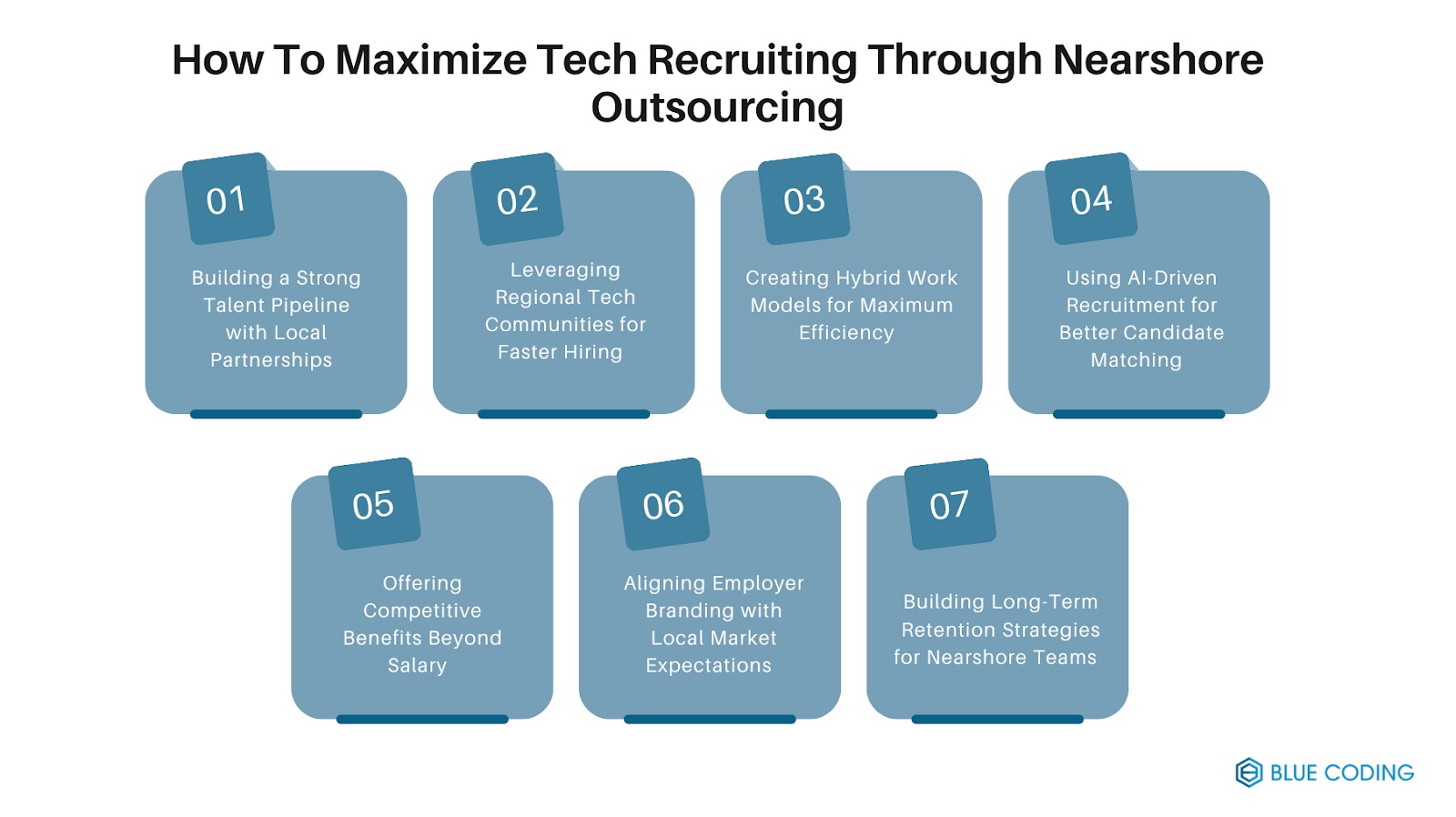 News
News
Tech recruiting is all about identifying, attracting, and hiring skilled professionals in the technology field. With the requirement of hiring developers, engineers, and IT specialists who are pros in specific skills keep growing, companies often struggle to find qualified candidates quickly. Simply posting job openings is no longer enough as businesses must actively seek out top talent, assess their skills effectively, and offer competitive benefits to stand out. The adoption of AI in recruitment has reached a significant milestone, with 87% of companies incorporating AI into their recruitment processes. This shift has transformed hiring strategies, making it easier to analyze resumes, predict candidate success, and streamline the recruitment process. As companies expand their search beyond local markets, outsourcing has become an increasingly popular way to access top-tier tech talent efficiently.
Why Companies Are Choosing Nearshore Outsourcing Over Other Methods
Easier Integration with In-House Teams:
When companies outsource work, they don’t want their external teams to feel like separate entities. Nearshore outsourcing supports effective developer retention strategies by fostering a sense of belonging and integration. Since nearshore teams operate in similar time zones and share cultural similarities, they can easily participate in company meetings, brainstorming sessions, and even social events. This strengthens teamwork and encourages natural collaboration between in-house and external employees. Unlike offshore outsourcing, where communication gaps can make outsourced workers feel disconnected, nearshore teams seamlessly become a natural extension of the company.
Faster Problem-Solving in Critical Situations:
In any business, unexpected problems happen, and how quickly they are solved can determine success or failure. With nearshore outsourcing, companies can address urgent issues much faster than they could with offshore outsourcing. If a critical bug appears in a software project or an unexpected client request comes up, having a nearshore team means businesses can immediately work together to find a solution. There’s no waiting overnight for a response, and troubleshooting can happen in real-time. This level of responsiveness gives companies a huge advantage in fast-paced industries.
Shared Holidays and Business Calendars:
One overlooked challenge in offshore outsourcing is the difference in national holidays and work schedules. A company in the U.S. might expect work to continue as usual, but an offshore team in India or the Philippines might be on a week-long holiday. This can cause delays and confusion. With nearshore outsourcing, companies benefit from having a more synchronized work calendar. Many neighboring countries share similar public holidays or have overlapping workweeks, making it easier to plan deadlines, schedule meetings, and ensure consistent workflow.
More Control Over Work Processes:
Outsourcing to a distant offshore team often means sacrificing some control over work processes. Time zone differences, communication delays, and cultural barriers can make it challenging to manage daily tasks and ensure projects progress smoothly. With nearshore outsourcing, businesses can maintain greater oversight, allowing for regular check-ins, real-time feedback, and quick adjustments when necessary. This not only boosts efficiency but also enhances tech talent retention by fostering better collaboration and a more integrated work environment.
Flexibility to Scale Teams Up or Down Quickly:
Companies don’t always need the same number of employees year-round. Some projects require more workers for a short period, while others may slow down, reducing the need for a large team. Nearshore outsourcing recruiting gives businesses the flexibility to scale their teams up or down depending on workload. Because nearshore teams work in a similar business environment, they understand the need for agility and can quickly adjust to changes. This is much harder with offshore outsourcing, where hiring or letting go of employees can involve lengthy contracts and legal complications.
Stronger Security and Intellectual Property Protection:
Data security and intellectual property (IP) protection are major concerns for businesses, especially in industries like tech and finance. With offshore outsourcing, companies may have to worry about weak data protection laws or security breaches. Nearshore outsourcing provides a safer alternative because many nearshore countries have stricter data protection regulations or agreements with the hiring country. Also, businesses can enforce legal contracts more easily and visit outsourcing partners in person to ensure their security measures are up to standard.
Encourages Economic Growth in Neighboring Countries:
Companies today are more aware of their social and economic impact. When they choose nearshore outsourcing, they help support economic growth in neighboring regions, which can lead to stronger business relationships in the long run. By investing in nearshore talent, businesses contribute to the development of skilled professionals, better infrastructure, and a healthier economy in nearby countries. This creates a positive business cycle where both the hiring company and the outsourcing country benefit, making nearshore outsourcing not just a smart business decision but also a responsible one.
Better Alignment with Legal and Compliance Standards:
Different countries have different labor laws, tax regulations, and compliance standards, which can create challenges when outsourcing. Offshore outsourcing often involves working with countries that have vastly different legal systems, leading to difficulties in contract enforcement, worker rights, and tax reporting. Nearshore outsourcing reduces these issues because neighboring countries tend to have more similar legal frameworks. This makes it easier for businesses to ensure that their outsourcing partners follow the same labor laws, data protection rules, and industry regulations, reducing legal risks and ensuring smoother operations.
Stronger Cultural Compatibility and Work Ethic:
Cultural differences can impact how teams communicate, work, and make decisions. Offshore outsourcing often leads to misunderstandings due to differences in business etiquette, work expectations, and even attitudes toward deadlines. Nearshore outsourcing minimizes these issues because neighboring countries usually have similar professional cultures. Employees share common business values, making it easier to collaborate, negotiate, and maintain a productive workflow. This cultural alignment leads to better teamwork, fewer miscommunications, and a more efficient work environment.
Cost Savings Without Extreme Trade-Offs:
While offshore outsourcing is often chosen for its lower costs, companies are realizing that the savings come with trade-offs like communication barriers, slower response times, and reduced quality control. Nearshore outsourcing provides a balance—offering significant cost reductions compared to hiring locally while maintaining a high level of quality and efficiency. Also, nearshore teams contribute to stronger developer retention strategies by fostering better collaboration, cultural alignment, and work-life balance. Since they operate in a similar economic environment, they offer competitive rates without sacrificing reliability, making nearshore outsourcing a cost-effective and practical choice for companies seeking both affordability and seamless teamwork.

How To Maximize Tech Recruiting Through Nearshore Outsourcing

Building a Strong Talent Pipeline with Local Partnerships.
One of the best ways to maximize tech recruiting through nearshore outsourcing is by establishing partnerships with universities, coding bootcamps, and tech hubs in the nearshore region. Many countries with strong IT industries have educational institutions that produce top-tier developers, but these graduates often struggle to find opportunities that match their skills. Companies that build relationships with these institutions can access a steady stream of fresh talent and even influence training programs to match their hiring needs. This approach ensures a direct line to skilled developers while also positioning the company as a desirable employer in the region.
Leveraging Regional Tech Communities for Faster Hiring.
Unlike traditional recruiting methods, hiring in nearshore locations benefits greatly from tapping into local tech communities. Many nearshore countries have thriving tech ecosystems with active developer forums, hackathons, and coworking spaces where engineers connect and share knowledge. By sponsoring events, networking in online communities, and engaging with influencers in the local tech scene, companies can create strong employer branding and attract top-tier candidates faster. This not only speeds up the hiring process but also ensures that candidates are already integrated into the region’s best tech networks, making collaboration smoother.
Creating Hybrid Work Models for Maximum Efficiency.
Many companies hesitate to outsource because they fear losing control over projects or communication gaps. However, a hybrid work model—where nearshore developers are embedded within in-house teams through overlapping work hours—can eliminate these concerns. Instead of treating outsourced teams as separate entities, businesses should integrate them into daily stand-ups, sprint planning, and company-wide meetings. This helps create a collaborative work environment that mirrors in-house teams while still benefiting from cost-effective nearshore outsourcing. The key is to use shared project management tools and real-time communication platforms to maintain a seamless workflow.
Using AI-Driven Recruitment for Better Candidate Matching.
Finding the right developers in a nearshore location requires more than just scanning résumés—it demands precise candidate matching. AI-driven recruitment tools can analyze technical skills, past project experience, and even soft skills to identify the best nearshore candidates for specific roles. These tools can also predict a candidate’s potential cultural fit with the company, reducing turnover rates. Since nearshore outsourcing works best when there is strong team integration, using AI to fine-tune candidate selection ensures that new hires can quickly adapt to the company’s workflow, making onboarding smoother and reducing time-to-productivity.
Offering Competitive Benefits Beyond Salary.
Many companies assume that nearshore outsourcing is only about cutting costs, but the best results come from offering developers attractive work conditions. To stand out, businesses should provide perks like flexible work hours, upskilling programs, and performance-based bonuses. Many nearshore regions have developers who are just as skilled as those in major tech hubs but may not have access to continuous learning opportunities. Companies that invest in their nearshore teams by providing certifications, mentorship programs, or tech conference sponsorships can build long-term loyalty, reducing turnover and ensuring a high-quality workforce.
Aligning Employer Branding with Local Market Expectations.
Companies looking to attract top nearshore tech talent must understand what matters most to developers in that specific region. In some countries, job stability and long-term contracts are the most appealing factors, while in others, remote work flexibility and project variety take priority. Understanding these expectations and adjusting employer branding accordingly can significantly boost hiring success. Businesses should localize their job postings, use testimonials from current nearshore employees, and highlight unique benefits that align with cultural preferences. This ensures that job ads don’t just attract candidates, but the right kind of candidates who are eager to grow within the company.
Building Long-Term Retention Strategies for Nearshore Teams.
The biggest mistake companies make with nearshore outsourcing is treating it as a short-term fix rather than a long-term investment. While hiring talented nearshore developers is important, keeping them engaged and motivated is what truly maximizes recruiting efforts. Retention strategies like career growth planning, leadership training, and cross-border team-building initiatives help nearshore employees feel valued. When nearshore developers see a future with the company, they are more likely to stay, reducing turnover and saving businesses from the constant cycle of recruiting and onboarding.
Hire Nearshore Developers With Blue Coding
Blue Coding is a reliable and renowned nearshore outsourcing agency that has been functioning for more than ten years. Our team of software developers and tech consultants prefer staying up to date with the changing technological trends. We provide custom development and staff augmentation services along with many other software services. To learn more about how we can fulfill your software needs, contact us and book your discovery call!



